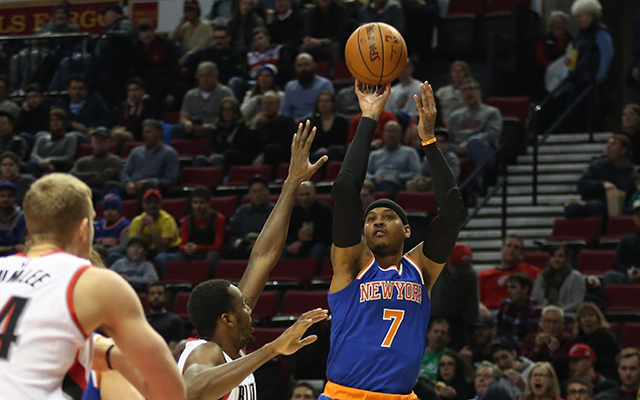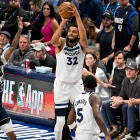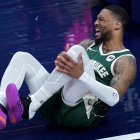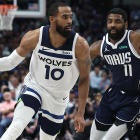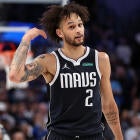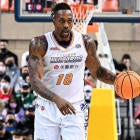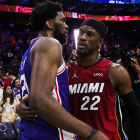People say numbers lie.
That's nonsense. Numbers don't have intentions, feelings or agendas. They can't bend what they are. Opinions? Opinions are flexible. Present someone with counter-evidence to their opinion and they can morph the hot take around it like molten metal forming around the mold. Numbers can only be what they are.
Now, what numbers can do is be presented outside of the proper context, without the right set of conditions and elements. They also can be interpreted as some sort of value judgment. People ascribe meaning to numbers, when in the end, that's all they are.
Numbers.
With that, we've got a little bit of a sample size, albeit not a very robust one, in this NBA season. I took a look at some numbers and found some things that stand out in spite of the eye test looking very different, or that you have to dig a little deeper to understand. Here are three examples in the NBA where the stats can, in fact, be considered deceptive.
1. The Warriors aren't as good on defense this season. Golden State's title season was best defined not by the Splash Brothers but by the fact that they led the league in defense per possession and pace (number of possessions per game). They were fast and great defensively, which is difficult to do.
The Warriors are 24-1, but rank just fifth in defense per 100 possessions, and are just 12th in defense in the last 15 games. So clearly, while the Warriors can still light up the nets, their defense has taken a step backward! Right?!
Wrong.
Check this out.
| Warriors Defensive Rating By Quarter | ||||
|
Quarter |
Defensive Rating (points per 100 possession allowed) |
Rank | ||
|
1st |
94.3 |
4th |
||
|
2nd |
100.2 |
12th |
||
| 3rd | 96.5 |
4th |
||
|
4th |
104.0 |
17th |
||
So they crush teams out of the gate, then coast for a while, then come back and put the hammer down, and then lose focus when the game's out of reach. The data suggests a pretty clear pattern that the Warriors just don't have the need to push themselves after establishing big leads. They coast. That doesn't mean they've slipped at all.
2. Derrick Rose has lost his athleticism. The Chicago Bulls guard is shooting 37 percent from the field this season, and in isolation, just 31 percent. He's made just 6 of 17 shots on drives out of isolation, in one-on-one situations. That's really bad. Rose is shooting 40 percent on all drives this year.
The natural assumption would be to say that he's simply lost his athleticism and can't drive anymore after all the knee injuries he suffered. But that's not the case. When you watch him it really seems like Rose still has burst and is able to attack. He's just not finishing.
Per NBA's SportVU data, Rose is actually 12th in drives per game. He's still able to get there. He just can't get the shot to fall. Here he puts his defender on skates, gets right to the rim in the gap ... and misses.
Sometimes it does look like Rose has the speed to get past a defender, but his leaping ability isn't there. George Hill hangs with him here.
The second defenders are really where he gets in trouble.
Rose also isn't drawing contact. In his MVP season in 2011, Rose drew free throws on 23 percent of all isolation drives. This season that number is just 11 percent.
Here there's no secondary defender and the defense has no chance against him.
So Rose's numbers suggest he can't drive anymore, and a deeper dive shows he definitely can, and he should, and those shots will probably start falling. He does, however, need to do a better job of drawing contact, if he can, given everything he's gone through physically.
3. The Knicks can't shoot. So New York has the 24th-ranked offense in the NBA, and are 27th in effective field-goal percentage. So it seems pretty reasonable to suggest that they just flat-out cannot shoot.
However, get this. They're 12th in the shots per game they produce that are "open" via NBA's SportVU data (defender 4-6 feet away), and 11th in effective field-goal percentage on those shots. So they produce a good number of quality looks, and they hit them at a high percentage. They do, however, produce the 18th-most "wide open" shots (defender more than six feet away) and shoot the third-worst effective field-goal percentage in the league on them.
They also are terrible on any sort of contested look. They are 10th in the number of contested looks (defender 2-4 feet away) and 17th in the number of tightly contested shots (less than two feet away) they create. The biggest problem, however, is those contested shots (2-4 feet away. They shoot an effective field-goal percentage of 45.4 on those shots, the seventh-worst in the entire NBA. On tightly contested, it's even worse. They shoot 40.2 percent effective field-goal percentage on those shots. That's where they just fall apart.

This chart shows that they take about the same number of tightly contested shots as the league average, and hit a worse percentage, and take more contested shots than the league average, even though they hit a worse percentage. That's not a decision-making point (necessarily), it's a function of the offense. They shoot fewer wide open shots than the league average and make a worse percentage.
The big culprit here is ... you guessed it, Carmelo Anthony. Forty-six percent of all of Anthony's shots come with a defender 2-4 feet away, and he's only shooting 41.5 percent (44.3 percent eFG percent) on those shots. You have to live with that to a degree, but Robin Lopez shooting 41.4 percent on contested shots isn't helping either.
The Knicks can actually shoot a little bit. They just take a lot of low-percentage shots, and don't make the super-easy ones.
